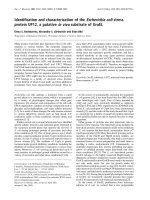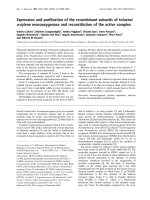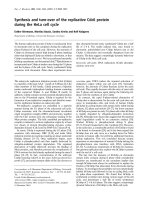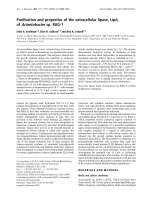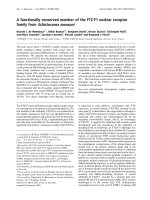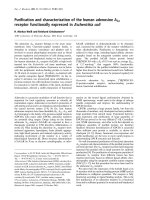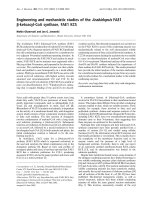Báo cáo y học: "Facing medical care problems of victims of sexual violence in Goma/Eastern Democratic Republic of the Congo"
Bạn đang xem bản rút gọn của tài liệu. Xem và tải ngay bản đầy đủ của tài liệu tại đây (239.94 KB, 5 trang )
SHOR T REPOR T Open Access
Facing medical care problems of victims of sexual
violence in Goma/Eastern Democratic Republic of
the Congo
Inipavudu Baelani
1*
, Martin W Dünser
2
Abstract
Background: Since 1998, the Eastern Democratic Republic of the Congo has been torn by a military conflict.
A particular atrocity of the war is widespread sexual violence.
Methods: In this combined retrospective analysis and prospective survey, we sought to identify hospital facilities
and resources available to treat victims of sexual violence in Goma, the capital city of the North Kivu province.
Results: Of twenty-three acute care hospitals registered in the area of Goma, four (17%) regularly cared for victims
of sexual violence. One hospital had all resources always available to appropriately care for victims of sexual
violence. From Jan 2009 until Oct 2010, 7,048 females sought medical care because of physical or psychological
sequelae from sexual violence in the four hospitals of Goma. Only half of the hospitals had physicians specialized
in gynaecology or gynaecological surgery available. Similarly, anaesthetists and psychiatrists/psychologists were
available in two (50%) and one (25%) hospital, respectively. Post-discharge care facilities, material resources, such as
surgical and anaesthesiological equipment and drugs, were inconsistently available in the hospitals caring for
sexually abused females. At one selected hospital, acyclovir and/or antibiotics were administered to 1,202 sexually
abused females (89.5%), whereas post-exposure HIV prophylaxis and surgery because of vesico-vaginal fistula was
provided to only 75 (5.6%) and 121 (9%) patients, respectively.
Conclusions: This study provides data that only few hospitals in Goma care for victims of sexual violence. In
addition, these hospitals suffer from a relevant shortage of human and material resources to provide adequate care
for sexually abused females. Aside from establishment of adequate protection strategies, steps must be taken to
increase the availability of trained health care professionals and resources to provide adequate care for victims of
sexual violence in Goma and the North Kivu province.
Background
Since 1998, the Eastern Democratic Republic of the
Congo has been torn by a military conflict characterized
by extreme violence, mass population displacements and
a collapse of public health services [1,2]. A particular
atrocity of the war is widespread sexual violence [3,4].
Systematic rape and unleashed sexual brutality against
femalesisusedbysoldiersandothercombatantsasa
weapon of war and has become known as the “war within
the war” [5]. A retrospective cohort study evaluated the
patterns of sexual violence of women presenting to a
hospital located in the capital of the South Kivu province
[6]. In contrast to other conflict settings, the majority of
sexual attacks occurred at night and in the women’sown
homes. Sexual violence was characterized by gang rape
carrying a high risk of serious injury and contracting
sexually transmitted diseases [6].
While the latter survey studied the situation in the
South Kivu province, a high prevalence of sexual vio-
lence has been reported in the North Kivu province,
too [3,4]. Just recently, a panel convened by the United
Nations High Commissioner for Human Rights has
travelled to six cities in the Eastern Democratic Repub-
lic of the Congo to meet victims of sexual violence. On
Oct 13, 2010, the panel reported its preliminary find-
ings and underscored that the needs of victims of
* Correspondence:
1
Department of Anaesthesiology and Intensive Care Medicine, DOCS
Hospital, Goma, Democratic Republic of the Congo
Full list of author information is available at the end of the article
Baelani and Dünser Conflict and Health 2011, 5:2
/>© 2011 Baelani and Dünser; licensee BioMed Central Ltd. This is an Open Access article distributed under the terms of the Creative
Commons Attribution License ( which permits unrestricted use, distribution, and
reproduction in any medium, provided the original work is properly cited.
sexual violence were largely unmet, particularly in
remote areas [7].
In this study, we sought to identify hospital facilities
and resources available to treat victims of sexual vio-
lence in the area of Goma, which is the capital city of
the North Kivu province in the Eastern Democratic
Republic of the Congo.
Methods
This analysis was designed as a combined retrospective
study and prospective survey. It was performed in the
city of Goma and the DOCS Hospital, which is a 40-
bed, non-governmental organization-run hospital
located in Goma. The study protocol was approved by
the Ethics Committee of the Medical University of
Goma. Since no direct patient data were retrieved and
hospitals were free to present data, written informed
consent was waived.
Study Objectives
Our study evaluated the time period from Jan 2009 until
Oct 2010 and had three main objectives: (1) assessment
of the number of victims of sexual violence seeking medi-
cal care in the hospitals of Goma; (2) assessment of the
availability of key resources to treat victims of sexual vio-
lence in hospitals regularly caring for victims of sexual
violence; and (3) assessment of the frequency of delivery
of three indicator treatments (antimicrobial therapy for
sexually transmitted diseases, post-exposure HIV prophy-
laxis, vesico-vaginal fistula repair surgery) to victims of
sexual violence at the DOCS Hospital in Goma.
Data Collection
Hospitals of Goma
Our survey evaluated all acute care hospitals located in
the area of Goma. According to the local health care
office, hospitals are defined as health care institutions
running at least 20 beds. The medical director or the
person specifically dedicated to the care of sexually
abused females at these hospitals was contacted and
asked whether victims of sexual violence were regularly
(at least one victim per week) cared for. If persons con-
tacted at each hospital stated that the hospital regularly
cared for patients following sexual violence, these insti-
tutions were visited and included in the survey. During
on-site visits consisting of personal interviews and visits
of key hospital facilities (e.g. outpatient department,
operation room, laboratory), the number of patients
admitted because of physical or psychological sequelae
of sexual violence during the observation period was
retrieved. Furthermore, data on the following resources
were collected using a predefined systematic protocol:
number of beds, administrative background, availability
of a physician specialized in gynaecological surgery or
gynaecology, anaesthetist, psychiatrist or psychologist,
post-discharge medical services, laboratory tests to diag-
nose pregnancy and sexually transmitted diseases (hepa-
titis, HIV, syphilis), instruments for gynaecological
examination, acyclovir, chinolone and/or tetracycline
antibiotics, post-exposure HIV prophylaxis, operation
room, instruments for basic wound care, instruments to
perform gynaecological surgery, basic surgical and
anaesthetic resources including an autoclave, suction
machine, electric cautery, oxygen, vaporizer to deliver
inhalational narcotics, patient monitor measuring at
least plethysmographic oxygen saturation, materials to
administer neuro-axial anaesthesia, and materials for air-
way management. Availability of drugs (including expiry
dates), laboratory tests (including expiry dates), instru-
ments, surgical and anaesthetic resources was documen-
ted as ‘always’, ‘sometimes’,or‘never’. Selection of these
resources was based on recommendations to manage
sexually violated females as published by the United
Nations Population Fund (UNFPA) and the United
Nations International Children’s Emergency Fund (UNI-
CEF), as well as practical experience of the authors.
DOCS Hospital
The DOCS hospital, which is supported by the non-
governmental organization ‘Doctors on Call for Service’,
was the first hospital in Goma to care for women fol-
lowing sexual violence. The reason for this was the
availability of a specialist surgeon providing surgical care
for sexually violated women (e.g. those with vesico-
vaginal fistula). Over the years, apart from orthopaedic
surgery, the DOCS hospital specialized in caring for
sexually abused women. The reason why the DOCS
hospital was singled out as an exemplary hospital to
provide data on the medical course of the patient in this
study is the fact that statistical data on the detailed
medical management of women after sexual violence
could not be retrieved from other hospitals.
The following data were collected from medical
records and the administrative register of the DOCS
hospital using a standardized protocol: total number of
hospital admissions, number of patients admitted fol-
lowing sexual violence, and percentage of sexually
abused patients receiving one of the following treat-
ments: acyclovir and/or antibiotics for sexually trans-
mitted diseases, post-exposure HIV prophylaxis, and/or
vesico-vaginal fistula repair surgery. Data were collected
for the period from Jan 2009 until Oct 2010.
Statistical Analysis
Statistical analyses were performed using the SPSS
13.0.1 software package (SPSS Inc.; Chicago, Illinois,
United States). Descriptive methods were used to pre-
sent data. Variables are presented as median with mini-
mum and maximum values, if not otherwise indicated.
Baelani and Dünser Conflict and Health 2011, 5:2
/>Page 2 of 5
Results
Of the twenty-three acute care hospitals registered in the
area of Goma (governmental, n = 5; non-governmental
organization, n =5;mission,n = 10; private, n =3)and
which met our inclusion criteria and were contacted,
four (17%) stated to regularly care for victims of sexual
violence and were visited for further data documentation.
One hospital had all resources always available to appro-
priately care for victims of sexual violence. During the
observation period, 7,048 females sought medical care
because of physical or psychological sequelae from sexual
violence in the four surveyed hospitals (Figure 1). Table 1
presents details of these hospitals. Availability of
resources to treat victims of sexual violence are summar-
ized in Table 2. Expiry dates of drugs and laboratory tests
were regularly checked by health district authorities in all
hospitals. None were expired. Where available, post-
exposure HIV prophylaxis consisted of zidovudine and
lamivudine.
From Jan 2009 until Oct 2010, 4,796 patients were
admitted to the DOCS hospital. One-thousand-three-
hundred-forty-three (28%) patients were admitted
because of physical or psychological sequelae following
sexual violence. Percentages of patients who received
one of the three evaluated specific treatments were as
follows: administration of acyclovir and/or antibiotics
for sexually transmitted diseases (n = 1,202; 89.5%),
post-exposure HIV prophylaxis (n = 75; 5.6%), and sur-
gery because of vesico-vaginal fistula (n = 121; 9%).
Discussion
In this study, we observed that only four of 23 registered
acute care hospitals in Goma cared for a total of 7,048
victims of sexual violence admitted during a 22 months
period. Resources to care for sexually abused females
were consistently available at a single non-governmental
organization-run hospital only. The other three health
care facilities faced comprehensive shortages of
resources. At one selected hospital, the majority of
women presenting after sexual violence received acyclo-
vir and/or antibiotics to treat or prevent sexually trans-
mitted diseases, whereas post-exposure HIV prophylaxis
or vesico-vaginal repair surgery was provided to only
few victims.
Interestingly, the four health care facilities which were
identified out of all acute care hospitals in Goma to pro-
vide regular care for sexually abused women were all run
by non-governmental institutions. A historical reason for
this may be the availability of resources, in particular
medical personnel (e.g. gynaecologists), to provide care
n=4,822
n=1,343
n=571
n=
312
Figure 1 Distribution of victims of sexual violence seeking
medical care at four hospitals in Goma during the observation
period (total number, n = 7,048).
Table 1 Characteristics of Hospitals
Beds n 112 (40-200)
Administrative Background n (%)
Non-governmental organization 2 (50)
Mission 1 (25)
Private 1 (25)
Availability of Medical Staff n (%)
Gynecologist or specially trained surgeon 2 (50)
Anaesthetist 2 (50)
Psychiatrist or psychologist 1 (25)
Availability of operation room n (%) 4 (100)
Availability of an autoclave n (%) 4 (100)
Post-discharge care n (%)
Continuous psychosocial support 1 (25)
Socioeconomic activities 1 (25)
Free law assistance 4 (100)
Data are presented as median with minimum and maximum values if not
otherwise indicated.
Table 2 Resource Availability in the Survey Hospitals
Always Sometimes Never
Laboratory tests
Pregnancy 1 (25) 3 (75) 0
Hepatitis B/C 0 0 4 (100)
Human immunodeficiency virus 4 (100) 0 0
Syphillis 0 4 (100) 0
Drugs
Acyclovir 1 (25) 2 (50) 1 (25)
Chinolone or tetracycline antibiotics 4 (100) 0 0
HIV post-exposure prophylaxis 1 (25) 3 (75) 0
Surgical equipment
Instruments for basic wound care 3 (75) 1 (25) 0
Instruments for gynecological
examination
1 (25) 3 (75) 0
Surgical instruments 1 (25) 3 (75) 0
Electric cautery 2 (50) 2 (50) 0
Suction machine 1 (25) 3 (75) 0
Anaesthesia equipment
Oxygen 1 (25) 2 (50) 1 (25)
Vaporizer to deliver inhalational narcotics 1 (25) 1 (25) 2 (50)
Patient monitor 1 (25) 2 (50) 1 (25)
Materials to provide neuro-axial
anaesthesia
1 (25) 3 (75) 0
Materials for airway management 1 (25) 2 (50) 1 (25)
Data are presented as absolute numbers with percentages in parentheses.
Baelani and Dünser Conflict and Health 2011, 5:2
/>Page 3 of 5
for sexually abused women at these institutions. Over the
years, apart from other medical fields, these institutions
evolved as specialized centers to provide care for victims
of sexual violence in Goma. Finally, the local health care
authorities selected the four institutions as referral
centers for the care of sexually abused females.
Shortages of resources to care for victims of sexual
violence in the few Goma hospitals appear multifaceted.
On the one hand, there is an obvious lack of adequately
trained health care providers, such as physicians able to
perform gynaecological surgery, anaesthetists, and psy-
chiatrists or psychologists, to care for sexually abused
females in- and outside the hospital. Our results regard-
ing inconsistencies in post-discharge care of sexually
abused females are in line with the findings of the
United Nations panel reporting unmet needs of victims
of sexual violence, particularly in remote areas [7]. The
lack of material resources (e.g. surgical and anaesthesio-
logical equipment, drugs) poses a relevant barrier to
adequate care of victims of sexual violence. The only
exception is chinolone and tetracycline antibiotics as
well as HIV tests which were reported to be consistently
available in all hospitals.
Selected data from the DOCS Hospital suggest that
the majority of females following sexual violence receive
acyclovir or antibiotics to treat or prevent sexually
transmitted diseases. In contrast, administration of post-
exposure HIV prophylaxis was very low. Given the high
prevalence of HIV infection among African soldiers [8],
prescription of post-exposure prophylaxis is recom-
mended for sexually abused females within 48-72 hours
of rape [9]. Two reasons can explain the strikingly low
rate of post-exposure HIV prophylaxis in the present
study cohort: First, women frequently seek medical care
followingsexualviolenceonlyafteratimedelaythat
precludes effective post-exposure prophylaxis. Secondly,
our results suggest that drugs for post-exposure HIV
prophylaxis are in short supply and can therefore not
even be administered to patients presenting within
48-72 hours following sexual violence.
The low number of hospitals caring for victims of sex-
ual violence together with the lack of human and mate-
rial resources has resulted in a substantial impediment
to medical care provided to sexually abused females in
the North Kivu province. Currently, it is estimated that
approximately 1,000 women and girls are waiting for
medical care following sexual violence in rural territories
around Goma (e.g. the Rutshuru, Lubero, Masisi, and
Walikale regions) since Nov 2009 (data retrieved from
the Health District Office Goma, Jan 2011). Considering
that many victims of sexual violence never seek medical
care and that some who seek medical care do so at
smaller hospitals or clinics outside of Goma, our survey
has the potential to relevantly underestimate the burden
of sexually abused females in Goma. The fact that some
females do not present to medical institutions at all
while others present only with a relevant delay may
diminish the benefit of sufficient human and material
resource availability to provide medical care for sexually
abused women. Aside from functioning referral systems
and transportation facilities, educational campaigns are
needed to inform victims about the time sensitivity of
post-rape care.
Our study carries several limitations. First, the study
was not piloted, and resources considered necessary to
care for sexually abused females in this study have not
been validated or shown to improve the care and out-
come of victims of sexual violence. In accordance with
international recommendations and practical experience
of the authors, these materials were regarded as indis-
pensable to provide adequate patient care. Second, con-
sidering the small sample size of surveyed hopitals, our
results must not be extrapolated to other areas of the
North Kivu province or Democratic Republic of the
Congo. Since the hospitals in Goma are referral hospi-
tals for the North Kivu province, it is, however, likely
that medical facilities and resources to provide care for
victims of sexual violence are even more limited in
remote areas of the region. Third, our study evaluated
only three indicator medical therapies provided to vic-
tims of sexual violence at a selected hospital and did not
comprehensively evaluate the medical care provided to
sexually abused females in Goma. This weakens the
conclusion of our study that resource restraints substan-
tially affect the quality of patient care. Finally, it is note-
worthy that not all information collected during
interviews could be verified during on-site visits of the
study hospitals.
Conclusions
This study provides data that only few acute care hospi-
tals in Goma care for victims of sexual violence. In addi-
tion, these hospitals suffer from a relevant shortage of
human and material resources to provide adequate care
for sexually abused females. Aside from establishment of
adequate protection strategies, steps must be taken to
increase the availability of trained health care profes-
sionals and resources to provide adequate care for vic-
tims of sexual violence in Goma and the North Kivu
province.
List of abbreviations
DOCS: Doctors on Call for Service; HIV: Human immunodeficiency virus;
UNFPA: United Nations Population Fund; UNICEF: United Nations
International Children’s Emergency Fund
Acknowledgements
FUNDING
The study was funded by private expenses of the authors.
Baelani and Dünser Conflict and Health 2011, 5:2
/>Page 4 of 5
Author details
1
Department of Anaesthesiology and Intensive Care Medicine, DOCS
Hospital, Goma, Democratic Republic of the Congo.
2
Department of
Anaesthesiology and Intensive Care Medicine, Salzburg General Hospital and
Paracelsus Private Medical University, Salzburg, Austria.
Authors’ contributions
IB designed the study, conducted the on-site survey, critically revised the
manuscript for important intellectual content and gave final approval of the
version to be published. MWD designed the study, drafted the manuscript
and gave final approval of the version to be published.
Competing interests
The authors declare that they have no competing interests.
Received: 24 July 2010 Accepted: 6 March 2011
Published: 6 March 2011
References
1. Centers for Disease Control and Prevention: Elevated mortality associated
with armed conflict - Democratic Republic of the Congo, 2002. MMWR
Morb Mortal Wkly Rep 2003, 52:469-471.
2. Alberti KP, Grellety E, Lin YC, Polonsky J, Coppens K, Encinas L,
Rodrigue MN, Pedalino B, Mondonge V: Violence against civilians and
access to health care in North Kivu, Democratic Republic of Congo:
three cross-sectional surveys. Conflict Health 2010, 4:17.
3. Omba Kalonda JC: Sexual violence in the Democratic Republic of Congo:
Impact on public health? Med Trop (Mars) 2008, 68:576-578.
4. Longombe AO, Claude KM, Ruminjo J: Fistula and Traumatic Genital Injury
from Sexual Violence in a Conflict Setting in Eastern Congo: Case
Studies. Reprod Health Matters 2008, 16:132-141.
5. Human Rights Watch: The war within the war: Sexual violence against
women and girls in Eastern Congo. New York, HRW; 2002 [http://www.
hrw.org/reports/2002/drc].
6. Bartels SA, Scott JA, Mukwege D, Lipton RI, VanRooyen MJ, Leaning J:
Patterns of sexual violence in Eastern Democratic Republic of Congo:
reports from survivors presenting to Panzi Hospital in 2006. Conflict
Health 2010, 4:9.
7. United Nations Human Rights: Democratic Republic of the Congo. [http://
www.ohchr.org/EN/Countries/AfricaRegion/Pages/ZRIndex.aspx].
8. Ba O, O’Regan C, Nachega J, Cooper C, Anema A, Rachlis B, Mills EJ: HIV/
AIDS in African militaries: an ecological analysis. Med Confli Surviv 2008,
24:88-100.
9. Meer BL: HIV/AIDS post-epxosure prophylaxis (PEP) for victims of sexual
assault in South Africa. Med Sci Law 2005, 45:219-224.
doi:10.1186/1752-1505-5-2
Cite this article as: Baelani and Dünser: Facing medical care problems of
victims of sexual violence in Goma/Eastern Democratic Republic of the
Congo. Conflict and Health 2011 5:2.
Submit your next manuscript to BioMed Central
and take full advantage of:
• Convenient online submission
• Thorough peer review
• No space constraints or color figure charges
• Immediate publication on acceptance
• Inclusion in PubMed, CAS, Scopus and Google Scholar
• Research which is freely available for redistribution
Submit your manuscript at
www.biomedcentral.com/submit
Baelani and Dünser Conflict and Health 2011, 5:2
/>Page 5 of 5



